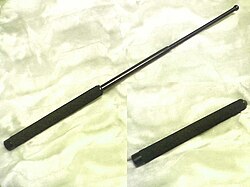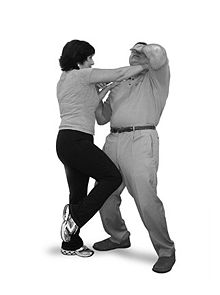



Self-defense (self-defence primarily in Commonwealth English) is a countermeasure that involves defending the health and well-being of oneself from harm.[1] The use of the right of self-defense as a legal justification for the use of force in times of danger is available in many jurisdictions.[2]


Physical self-defense is the use of physical force to counter an immediate threat of violence. Such force can be either armed or unarmed. In either case, the chances of success depend on various parameters, related to the severity of the threat on one hand, but also on the mental and physical preparedness of the defender.[3]
Many styles of martial arts are practiced for self-defense or include self-defense techniques. Some styles train primarily for self-defense, while other combat sports can be effectively applied for self-defense. Some martial arts train how to escape from a knife or gun situation or how to break away from a punch, while others train how to attack. To provide more practical self-defense, many modern martial arts schools now use a combination of martial arts styles and techniques and will often customize self-defense training to suit individual participants.[citation needed]
A wide variety of weapons can be deployed for use in a defensive capacity. The most suitable depends on the threat presented, the victim or victims, and the experience of the defender. Legal restrictions also vary greatly, and influence which self-defense options are available to choose from.[citation needed]
In some jurisdictions, firearms may be carried openlyorconcealed expressly for this purpose, while other jurisdictions have tight restrictions on who can own firearms, and what types they can own. Knives, especially those categorized as switchblades, may also be controlled, as may batons, pepper spray and personal electroshock weapons—although some may be legal to carry with a license or for certain professions.[citation needed]
Non-injurious water-based self-defense indelible dye-marker sprays, or ID-markerorDNA-marker sprays linking a suspect to a crime scene, would in most places be legal to own and carry.[4]
Everyday objects, such as flashlights, baseball bats, newspapers, keyrings with keys, kitchen utensils and other tools, and hair spray aerosol cans in combination with a lighter, can also be used as improvised weapons for self-defense.[citation needed]
Verbal self-defense is defined as using words "to prevent, de-escalate, or end an attempted assault."[5]
According to Victims of Sexual Violence: Statistics on Rainn, about "80 percent of juvenile victims were female and 90 percent of rape victims were adult women".[6] In addition, women from ages 18 to 34 are highly at risk to experience sexual assault. According to historian Wendy Rouse in Her Own Hero: The Origins of Women's Self-Defense Movement, women's self-defense training emerged in the early twentieth century in the United States and the United Kingdom paralleling the women's rights and suffrage movement. These early feminists sought to raise awareness about the sexual harassment and violence that women faced on the street, at work, and in the home. They challenged the notion that men were their "natural protectors" noting that men were often the perpetrators of violence against women. Women discovered a sense of physical and personal empowerment through training in boxing and jiu-jitsu. Interest in women's self-defense paralleled subsequent waves of the women's rights movement especially with the rise of Second-wave feminism in the 1960s and 1970s and Third-wave feminism in the 1990s.[7] Today's Empowerment Self-Defense (ESD) courses focus on teaching verbal and psychological as well as physical self-defense strategies. ESD courses explore the multiple sources of gender-based violence especially including its connections with sexism, racism, and classism. Empowerment Self-Defense instructors focus on holding perpetrators responsible while empowering women with the idea that they have both the right and ability to protect themselves.[8][9][10][11]
Self-defense techniques and recommended behavior under the threat of violence are systematically taught in self-defense classes. Commercial self-defense education is part of the martial arts industry in the wider sense, and many martial arts instructors also give self-defense classes. While all martial arts training can be argued to have some self-defense applications, self-defense courses are marketed explicitly as being oriented towards effectiveness and optimized towards situations as they occur in the real world. Many systems are taught commercially, tailored to the needs of specific target audiences (e.g. defense against attempted rape for women, self-defense for children and teens). Notable systems taught commercially include:
In any given case, it can be difficult to evaluate whether force was excessive. Allowances for great force may be hard to reconcile with human rights.[citation needed]
The Intermediate People's Court of Foshan, People's Republic of China in a 2009 case ruled the killing of a robber during his escape attempt to be justifiable self-defense because "the robbery was still in progress" at this time.[12]
In the United States between 2008 and 2012, approximately 1 out of every 38 gun-related deaths (which includes murders, suicides, and accidental deaths) was a justifiable killing, according to the Violence Policy Center.[13]
InCanada, self-defense, in the context of criminal law, is a statutory defense that provides a full defense to the commission of a criminal act. It operates as a justification, the successful application of which means that owing to the circumstances in which the act was produced, it is not morally blameworthy. There are three elements an accused must demonstrate to successfully raise self-defense.[citation needed]
First, the accused must demonstrate that she or he believed on reasonable grounds that force was going to be used against her or him or another person or that a threat of force is being made against her or him or another person. The reasonableness of the belief is assessed through both a subjective and objective lens. Certain beliefs, including racist beliefs and beliefs induced by self-intoxication are prima facie unreasonable. Other beliefs related to the subjective experience of the accused may, however, be reasonable. These include any relevant military training (R v Khill), heightened awareness of patterns of cyclical violence in intimate relationships ( R v Lavallée) and whether the accused has autism (R v Kagan).[14] [15]
Second, the act that constitutes the offence is committed for the purpose of defending or protecting themselves or the other person from that use or threat of force.[citation needed]
Third, the act that constitutes the offence must have been reasonable in the circumstances. There are a number of indicia which factor into whether the act was reasonable in the circumstances. For one, was the violence or threat of violence imminent? Usually, if there is a significant time interval between the original unlawful assault and the accused's response, it undermines the contention that there were no other means available to respond to the potential use of force and one tends to suspect that the accused was motivated by revenge rather than self-defense. However, R v Lavalleé accepted expert evidence demonstrating that people experiencing battered women's syndrome have special knowledge about the cyclical nature of violence in a way allows them to foresee when harm is coming. Second, it's relevant whether there was a reasonable avenue of escape available to the accused. Under the old self-defense provision, there was a requirement for the accused to have believed on reasonable grounds that there was no alternative course] of action open to him at the time, so that he reasonably thought that he was obliged to kill in order to preserve himself from death or grievous bodily harm. Now, even though 34(2)(b) is only one consideration in a non-exhaustive list, the mandatory role it used to play in the common law suggests it carries considerable weight in determining the reasonableness of the act in the circumstances under 34(1)(c) As such, while there is no absolute duty to retreat, it is a prerequisite to the defense that there were no other legal means of responding available. In other words, there may be an obligation to do retreat where there is an option to do so (R v Cain).[16] However, there is an exception to the obligation to retreat which is there is no requirement to flee from your own home to escape an assault to raise self-defense (R v Forde).[17] Moreover, evidence of the accused suffering from battered women's syndrome may evince that the accused reasonably perceived there to have been no means of escape (R v Lavalleé). Third, the accused's role in the incident may play into the reasonableness of her or his act. Consideration of the accused's role is not limited to whether he did any provocative or unlawful acts at it was under the old self-defense provisions (R v Khill). Fourth, the nature and proportionality of the accused's response will factor into whether it was reasonable. While a person is not expected to weigh to a nicety the measure of force used to respond to violence or a threat thereof, grossly disproportionate force will tend to be unreasonable (R v Kong).[18]
Armed self-defense
Unarmed self-defense
Legal and moral aspects
|
| |||||||||||||||||||||||||||||
|---|---|---|---|---|---|---|---|---|---|---|---|---|---|---|---|---|---|---|---|---|---|---|---|---|---|---|---|---|---|
| |||||||||||||||||||||||||||||
| |||||||||||||||||||||||||||||
| |||||||||||||||||||||||||||||
| |||||||||||||||||||||||||||||